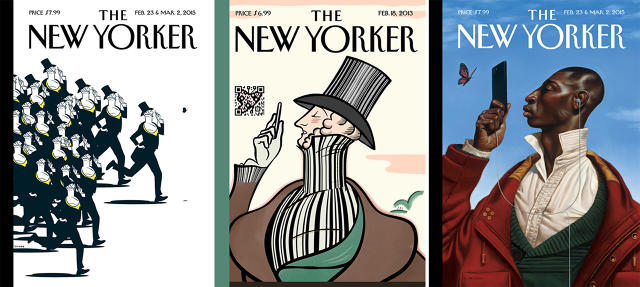How To Be Funny In Brief, From a Writer For “The New Yorker” and “Inside Amy Schumer”
She writes sketches on Inside Amy Schumer and short humor for The New Yorker. Here’s how Hallie Cantor stays succinctly funny.
Brevity is soul. Usually that quote is longer, but who has that kinda time? With so much content competing for our attention, there’s a lot to be said for doing more with less. Unless there’s a way to say that with fewer words.

Hallie Cantor is more invested in the economy of words than most. As a writer for the incisive sketch show, Inside Amy Schumer, and a frequent contributor to The New Yorker’s humor section, Shouts & Murmurs, her prime directive is keeping it brief and all killer, no filler. Both her written and filmed pieces hum with the energy of modern-day anxiety, and never trouble their audiences with worry that they’ll outstay their welcome.
When Cantor was writing for the campus satirical newspaper at Brown University, she realized she had a talent for delivering humor in sustained short bursts. After a stint at uber-comedy blog, Splitsider, Cantor joined the editorial team at CollegeHumor, contributing written pieces and working on sketches. It didn’t take long for her material to attract wider attention.
While she enjoys writing short pieces in magazines and on Inside Amy, Cantor is also preparing to branch out. She’s written a couple TV pilots, done some punch-up work on sitcoms, and has ambitions for feature-length screenwriting some day. In the meantime, though, she’s just focused on cramming as many laughs as possible in the smallest spaces. Co.Create spoke with her recently for some tips for efficiently packing a punchline.

Inspiration Courtesy Of Deadlines, And Complaining
“I spend a lot of time complaining and talking about myself to anyone who will listen,” Cantor says. “Sometimes I catch myself spending a lot of time in my head repeating thought patterns and it suddenly strikes me as sort of ridiculous and worth articulating—in the sense that maybe other people also engage in those same mental patterns and will relate to them. I’ve gotten more than one Shouts & Murmurs idea while on the phone with my sister talking at length about how we’re both ‘just kind of tired lately.’
Some ‘Shouts’ ideas come organically, but I do get the most done sitting down purposefully to brainstorm for a specific thing. I love having deadlines and assignments because they force me into creativity. A specific goal is key—it’s a million times harder for me to think, ‘What’s a funny idea?’ than ‘What’s a funny three-page sketch for a particular show or website’s voice?'”

All Ideas Deserve Their Day In Brain-Court
“About 90% of the time, when I have an idea, I am already sitting in front of my laptop in varying levels of misery and giddiness—depending on how long it’s been since I’ve either written something good or played with a dog,” Cantor says. “So I write everything I think/feel down in this one secret Google doc called Not To Forget List, originally named because it was meant to be a list of things I didn’t want to forget to do. Now it is an unwieldy 52-page depository for brain garbage and if anyone saw it I’d die of shame. Most of the jokes in short pieces tend to stem from the central funny idea (the game, if you will). So if I have a random funny thought I’ll usually just tweet it. Twitter is mostly a distraction, but sometimes distraction is necessary to not go insane.”

I have tons of half-ideas that I never even start, but I’ve also dismissed an idea and come back to it. Very recent example: I thought of the idea of writing GPS directions for getting home from a party when you’re drunk back in January, thought it could have potential but also might be totally lame and formulaic, then picked it back up this summer and wrote it in a day or two, and The New Yorker published it in the fall. Thank god people get drunk all year long so it was still topical.”
Deciding What To Do With A Worthy Idea
“Both feel pretty similar to me, but I think a sketch may require a bit more of an explosive or twist-y ending, whereas for a written piece, the ending might just be consistent with a format you’re mimicking, or a quiet joke that stays with you—not necessarily the ‘biggest’ joke in the piece,” Cantor says. “Having said that, I frequently don’t know what the end of something is going to be until I get to it.
Another way I decide the best format is if, say, an idea is centered around something that happens in the interactions between people, a sketch might be the most direct way to show it. But usually when I’m just writing my own stuff, I tend to default to a written piece because then once it’s written it’s more or less finished. Sketches need to be put into the world by actors and directors and producers and editors and that sounds like a lot more work.”
Refining By Committee Gets It Sharper, But Less Personal
“At Inside Amy Schumer, we beat out a sketch in the room, write a draft, get notes from the head writers, revise the draft, and then read through line by line and punch it up all together,” Hallie says. “For The New Yorker, I’ll usually get notes or an edit from the online ‘Shouts’ editor or the print ‘Shouts’ editor or both, and maybe make one more pass through it. There’s more refining when you’re part of a writers’ room trying to make something perfectly fit the voice of the show vs. when you’re submitting a piece in a publication that’s meant to remain generally in your voice, with your byline.”
The One That Got Away (But May Be a DVD Extra)
“I wrote a sketch called ‘Engagement Shoot’ that didn’t air, but I believe is on the season 3 DVD,” says Cantor. “I’m at an age where it feels like every other day someone on my Facebook feed is posting 200 photos of themselves in a gauzy dress looking contemplative with their fiancee in a sun-drenched meadow, and it was very satisfying to bring that into the writers’ room at Schumer and feel pretty confident that I could take it to a really absurd place that still got at something true about the way we are all presenting ourselves on social media.”

It’s Just Comedy Math—But If The Writer Had Fun, It Shows
“One benefit of writing short pieces is that once I start them, I do tend to finish,” Cantor says. “I think I’ve gotten decent at recognizing when an idea has enough potential juice to sustain a sketch or a page-long piece, and after a certain point it’s just comedy math—you plug in a bunch of things from this column and a bunch from that, and it’s technically done. That doesn’t mean it’s good. But it is done! As far as challenges go, on a micro level, it’s: avoiding cliches. On a macro level: uncertainty, doubt, loneliness. (Possibly the same challenging parts of being a human? I think I’m just talking about how hard life is.) You have to give yourself permission to be bad when starting something, though. Inertia is real and you can make it better later. Also, when someone has fun writing something, you can tell.”
Fast Company , Read Full Story
(48)










